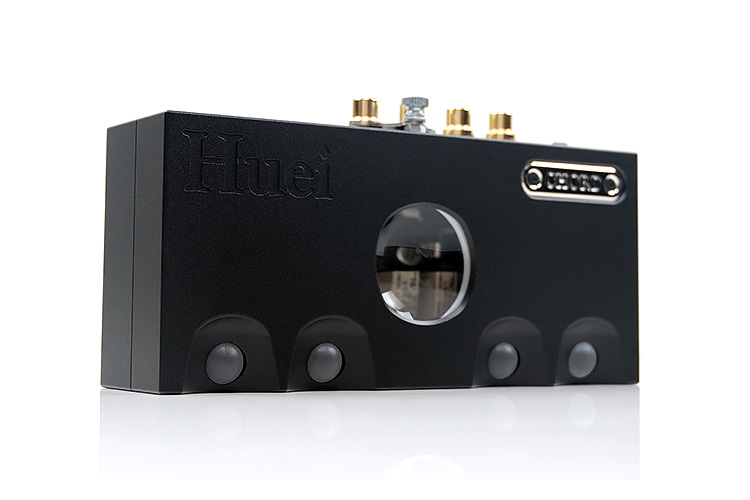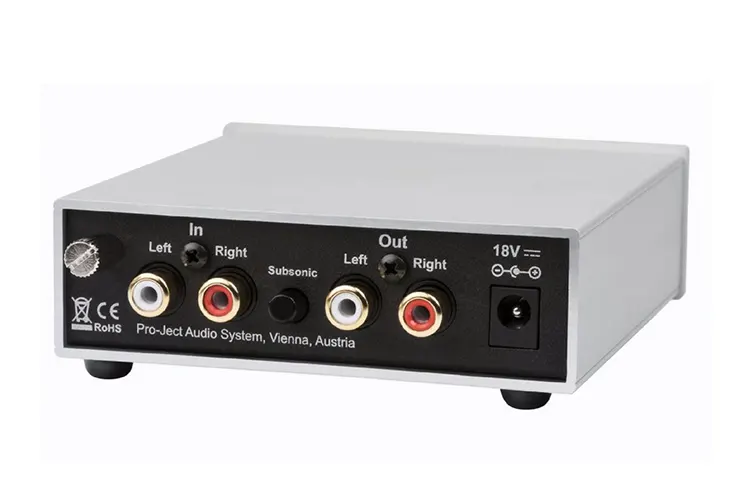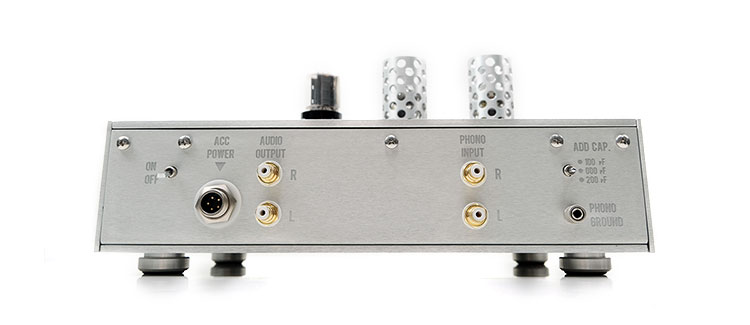Select Comparisons
The following comparisons were completed using a mix of the ALO Audio Studio 6, the Chord Electronics Anni, and the HIFIMAN Prelude amplifiers combined with the ZMF Headphones Atrium, the Audeze MM-500, and the Abyss Headphones Diana TC. The turntable used was a Rega Planar P1 Performance Pack with Carbon and Bias 2 MM cartridges.
Pro-Ject Audio Phono Box S2
The Pro-Ject Audio Phono Box S2 is a second-generation phono stage and like the Studio 6 Phono stage was launched several years ago. It is much cheaper than the Huei at $199 with most seeing it as an excellent entry-level phone stage.
Technical
Both of these phono stages are dual MM and MC compatible with the Phono S preamplification a dual mono design using SE input/outputs. This contrasts with Huei’s fully balanced architecture with an RCA input and the option of going either RCA or XLR for output.
Both of these Phono stages have plenty of user-adjustable options. However, the microprocessor controller of the Huei has an advantage over the Phono Box S2 which uses a dip-switch system on the base of the unit combined with a single switch for rumble on the rear panel.
The S2 subsonic filter is also set lower at 20Hz at -18 dB per octave below as opposed to 50Hz downwards at -24 dB per octave for the Huei.
Even if you find the Huei Orb color system challenging without the reference card, it’s still much easier to use than the dip-switch of the Phone Box S2. You need to pay careful attention to your switch combinations for MC carts and changing settings is more time-consuming.
The impedance values on the Box S2 are more limited with just 3 impedance values instead of 6 at 10Ω, 100Ω, 1kΩ, and 4 capacitance values whereas the Huei has 6.
Gain is a feature of both phono stages though again more limited for Box 2 with 2 values for low output MC at 40/43 dB and 2 for MM with high output MC at 60/63 dB.
The Huei will give you 8 gain values that in turn morph into 16 options with 8 for RCA and 8 slightly higher values for its XLR output. On SE MC carts it’s 49-70 dB and for the XLR equivalent on MC it’s 55-76 dB. For MM it drops to 21-42 dB for MC on its RCA output and 27-48 dB on its XLR output.
Design
The Box S2 is tiny, even when compared to the Huei which I already consider to be quite a compact unit. It is also a ‘plain Jane’ design, living up to the ‘box’ name with a generic albeit nicely curved chassis and front plate made out of an aluminum steel alloy.
There is a method in the madness though with that plain-looking housing also designed specifically to prevent unwanted electromagnetic interferences and vibrations. Still, the aluminum billet housing of the Huei feels much stronger and probably thicker also so I suspect it’s doing the same job here if not more so.
With such a small box, the options are more limited for both controls and I/O. You get the default RCA for both input and output, a small rumble filter switch in between, a grounding post, and the 18V DC input.
The Huei adds dual XLR for its output with an additional grounding connector plate for the RCA inputs to link up to the grounding post above them.
As mentioned, all the controls aside from power and the rumble filter on the Box 2S are dip switch controlled on the base whereas the Huei Orb system on top takes care of everything.
Neither is super easy but I would go with the Orb system because it’s right there for your lazy hands to rotate through the options without lifting it, turning it over, and messing with switches using a tweezer.
All of that switching must also be done with the power turned off on the Phono Box S2, unlike the Huei which can remain powered up.
Setup
Both phone stages were set to MM with a 40 dB gain rating for the S2, (lowest setting) and 42 dB for the Huei (which is the highest setting but also the closest match). Both pairings were tested using the RCA input of the Chord Electronics Anni amplifier and the Audeze MM-500 headphones.
Performance
The first challenge was noise, specifically the link between the level of gain and how much noise was creeping into the background for each stage.
With both stages set at 40 and 42 dB respectively, the Huei was delivering more noise when the needle was off the groove compared to the Box S2.
However, dropping the gain on the Huei to around 25 or 30 dB reduced the audible noise so I have to presume here the Huei pre-amp base gain level and/or output voltage is higher than the Box S2. The rumble filter also made a bigger difference to noise filtering than the S2’s subsonic filter.
The Huei does have the benefit of being able to go right down to 21 dB gain which reverses the issue. With the S2’s lowest level being 40 dB it now sounds the noisier of the two pre-amps.
However, you will need an amplifier with plenty of power to compensate for the Huei’s low gain quiet volume levels. The Anni volume had to move significantly higher with the MM-500 and the Huei when set at 21 dB.
Tonally, the Huei delivered a much richer and more refined quality to the MM-500/Anni pairing compared to the S2. The Phono Box S2 sounds a lot drier and cleaner, especially through the upper mids and highs where some of my recordings produced some unwanted harmonic dissonance.
For example, Joe Elliot’s vocal performance on the 2017 180g Hysteria release should sound earthy and gravel-toned which the Huei picks up on right away. The vocal harmonization overlay also had a nice natural liquid smoothness to it.
With the S2, the same passages sounded steelier and less forgiving. A shallower bass was also creeping through from the S2 which probably contributed to the brighter sound.
ALO Audio Studio 6 Phono Stage
The ALO Audio Studio 6 Phono Stage was launched quite a while ago in 2014 and featured alongside the main Studio 6 desktop SET headphone amplifier. It is now discontinued but launched at a very similar US price to the Huei at $1849.
Technical
The most obvious difference between these two is the pre-amplification topology with the ALO Audio version using a single-ended triple-stage Class A triode, (tube), amplification per channel.
It’s a more minimalist approach in the sense that all settings, for what there is, are switch-controlled at the rear of the unit. For MC cartridges you do get 3 options with a rear switch but they are for high output designs ranging from 1 to 10mV. For MM, it’s a preset for the default value of 47,000Ω.
Everything else is more or less automated or fixed with passive RIAA equalization. There is no externally controlled rumble filter similar to the Pro-Ject Audio Phono Box S2 or the Huei.
The Huei is a fully balanced solid-state architecture with a hybrid mix of discrete transistor and opamp circuitry combined with an internal switch-mode power supply.
It does have a lot more user-controlled options including a wider range of impedance values for MC and an 8-stage gain control with additional rumble filtering on the front-end. To control all that, Chord has used an ultra-low-noise microprocessor with a memory function to store user input values.
Both of these units have power supplies that can operate in ‘slave mode’ to the matching amplifier in the range.
The Huei can receive a 12v input from the Anni amplifier, and the ALO Audio Phono Stage is wired up to receive a filtered power feed from the Studio 6 amplifier via a 5-pin AC link making it less flexible for 3rd party amplification pairings.
The Huei can hook up with alternative amplifiers since it comes supplied with its own independent 12v power supply.
Design
The Stage 6 Phono Stage is huge when placed beside the Huei. Measuring in at 12.5″ x 6 3/4″ x 9″ and weighing in at 7lbs it stands wider, taller, deeper, and almost 3kg heavier than the compact Huei.
This is not a tuck-and-hide phone stage, it is not discreet but then again, it’s a beautiful retro-styled brushed aluminum finish with tubes, (and tube guards) so why would you hide it? Its design language perfectly matches that of the main Studio 6 amplifier and as such, this combo has been rack 1 and rack 2 in my HiFi display for years.
The Huei is much more discreet though its design language is no less of a talking point. You can certainly tuck it out of sight if you choose or neatly stack it with the Qutest and the Anni in a relatively small space if required.
The design language of the Huei is more urban, more modern, and via the orb system, maybe more opaque on what it can do to the first-time user. A learning curve is required here to manage the deep suite of options where none is required for the minimal switches on the ALO Audio Phone stage.
The Stage 6 Phono controls are very straightforward with switches and clearly labeled I/O to the rear but given the size, I would have preferred the impedance switch to have been more accessible.
It is also RCA-only for both input and output whereas with the Huei you get a choice of XLR or RCA output. Both have grounding posts though the connecting plate on the Huei is a useful, albeit needed addition, especially for Rega tone arms.
Setup
For this setup, I ran both phone stages in RCA through the Studio 6 headphone amplifier with the Rega Planar P1 and their Bias 2 cartridge with a tracking weight of 1.75g on the tonearm. Since this is a Class A SETA headphone amplifier I paired it with the 300Ω ZMF Headphones Atrium.
Performance
As with the S2, the gain/noise floor levels between these two high-end stages were handled quite differently.
Since there is no gain setting on the Stage 6 Phono Stage I presume it is set fairly high or at maximum because the synergy from the Atrium to the Stage 6 amplifier was at a much lower volume level compared to the Huei which needed a lot more volume at its maximum gain setting of 42 dB, (MM, single-ended).
Trying to volume match with the Huei at maximum gain meant a lot more audible noise floor crept in compared to the Studio 6 which was quieter in comparison. Lowering the gain on the Huei reduced the audible noise but required volume levels to shoot up.
Tonally, the Huei is weightier sounding and extends deeper than the Studio 6. The Studio 6 phone stage dynamics are very good but with less density and more pace creating a wider airier presentation.
I thought the Huei sounded a little darker and softer on the highs with the Atrium timbre offering a rounded ‘heavier’ quality to instrumental notes. Whereas the Studio 6 Phono stage delivered a more euphonic and slightly sweeter overtone.
Piano timbre in particular showed off these differing characteristics with the 2008 print of Ultravox’s atmospheric Vienna recording.
The Huei has a stronger focus on the rhythm of the track and the vocal presence. Studio 6 pushed that back a little, creating more space to produce a more grandiose and taller sound with a slightly lighter note quality.
One thing I would have liked to have tested on Stage 6 was some sort of subsonic or rumble filter. With it on, you can hear the Huei’s 50Hz region sound more refined with a better level of presence for instruments right up to the mids.
Our Verdict
The Chord Electronics Huei delivers a powerful and weighty sound signature combined with an elegant and compact form factor making it a worthy upgrade on run-of-the-mill mid-fi phono stages, or at least the ones I have tried to date.
If you are invested in the Qutest series of components from Chord the addition of the Huei is a no-brainer given they share the same design language and dimensions.
The stacking system and the ability to draw power from the Anni rather than use another external power supply is ideal for those with limited space.
Some caveats though. The noise levels were a bit higher than my competing Stage 6 Phono stage when using MM at maximum gain. Lowering the gain reduced it but left me struggling with volume headroom from the tested amplifiers.
The good news is that the rumble filter does reduce some of that perceived noise and the connecting grounding plate also did its job so there are some options there.
The only other bad news is that after 8 years of contentment, I am now shopping for a better turntable and accompanying MM cart. Such is the knock-on effect of the improvement the Huei brought to my analog setup. Well, it is Xmas after all.
Chord Electronics Huei Specifications
- Input Impedance:
- Moving magnet: 47,000Ω
- Moving coil: 100Ω – 3,700Ω, 12-step user selectable
- Gain Range:
- Moving magnet: 21dB – 42dB, 8-step user selectable
- Moving coil: 49dB – 68dB, 8-step user selectable
- Input Noise: 1.1nV/Hz
- Max Output Voltage RMS: 20v RMS
- Equalization Response: RIAA Curve
- Equalization Accuracy: +/- 0.1dB
- Frequency Response: RIAA Curve = 12Hz to 25kHz
- Rumble Filter: Rausch Slope -24dB per octave below 50Hz
- Output Impedance: 520Ω (resistive)
- Input Power Supply: 12v – 100v to 240v 50/60Hz PSU
- Dimensions: 4.5cm (H) 16cm (W) 8.8cm (D)
- Weight: 657g






